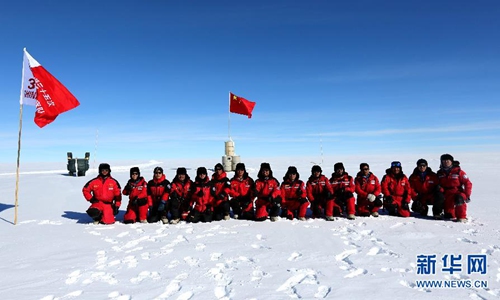To keep hegemony, US trying to obstruct China’s rights in Arctic

By Chen Zinan
The US Senate voted 76-6 on December 16 to advance a $738 billion defense bill. The National Defense Authorization Act (NDAA) for Fiscal Year 2020 for the first time included a section on a report on so-called Chinese foreign direct investment (FDI) in the Arctic region, signaling its intention to spread the Arctic version of the “China threat” theory.
Given Section 1260E of the NDAA, the report has broad requirements covering projects that are “directly or indirectly funded by public and private Chinese entities,” including public and finance infrastructure, energy, real estate, ship building, and telecommunications. The study shall include an analysis of the Chinese FDI that is being implemented in the US, Russia, Canada, Greenland, Norway, and Iceland, with an assessment of the efficacy and transparency of these countries’ criteria, methods for monitoring, and public reporting. In addition, the bill also requires a review of China’s strategic objectives in the Arctic region from a military, economic, territorial, and political perspective, so as to summarize the model by which China increases its influence in the region.
Since 2014, the US has been showing increasing interest in terms of national security in the region. Particularly after US President Donald Trump took office, he changed his predecessor Barack Obama’s policy that underlined cooperation and environmental protection in the Arctic to one that underscores great power competition and the importance of development.
The keynote of US policy in the Arctic is to maintain its leadership and position of rule maker while preventing China and Russia, its long-term competitors, from injecting influence in the Arctic. Such stance has been repeatedly reiterated during the past year, and the NDAA for Fiscal Year 2020 is actually the beginning of implementing relevant US policies.
US Secretary of State Mike Pompeo and former national security adviser John Bolton have publicly accused China of being present in the Arctic region. They condemned Beijing for adopting “debt diplomacy” with investment in countries in the region and called for pushback against China’s near-Arctic status. However, as it turned out, US intention to create tensions by slandering and excluding its main competitors in the Arctic didn’t work, but backfired.
In the wake of “independent study” of Chinese FDI in countries of the Arctic region, the US Department of Defense will inevitably take measures to comprehensively reject and contain China’s projects. There are two possibilities worthy of attention.
After getting an overall picture of China’s activities in the region, the US could change its strategy from whack-a-mole-style attacks to an all-round and systematic siege. China’s economic cooperation projects with Iceland and Greenland, development of new shipping routes, and civil and military infrastructure development will be key projects for the US to obstruct.
In the meantime, Washington could further call for the establishment of an economic cooperation order in the Arctic region with monitoring and censorship mechanism to set up a system threshold for non-Arctic countries’ economic activities. In addition to an “invisible wall” of ecological protection and aborigines’ rights that would be raised, the US would also require other countries to be “one-way transparent” toward it and conform to the rules that limit these countries’ rights and allocate their responsibilities.
The Arctic region is standing at an important historical turning point, facing various new challenges in governance, which concerns sustainable development of the human society and the ocean. All countries should take the opportunity, uphold equality and respect, and abandon pride and prejudice, so as to promote pragmatic cooperation and safeguard peace as well as stability in the region.
China is a near-Arctic country. It has been participating in the region’s affairs with an inclusive, cooperative and win-win attitude. It is not a courtesy extended by Arctic countries but a right endorsed by the international law that allows China to take part in regional affairs. China’s deepening cooperation with regional countries is not a threat to the Arctic region but rather a mutually beneficial combination of these countries’ development need and China’s strength in production capacity.
This is proved by the China-proposed Ice Silk Road that has been welcomed and made big achievements. However, the US groundlessly criticized China’s cooperation projects in the Arctic region. The US move contradicts Arctic countries appeal for peace, stability and development, and unsurprisingly backfired.




